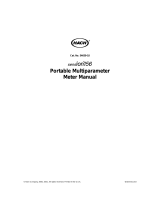
2. Turn the instrument on. If using a polarographic sensor, wait 10 minutes for the
DO sensor to stabilize. Galvanic sensors do not require a warm up time.
3. Ensure the barometer reading along the bottom of the display is accurate.
4. Press and hold the Cal key for three seconds.
5. If Quick DO Cal is enabled, highlight Dissolved Oxygen and press enter. The
instrument will then indicate Calibrating %DO on the display and automatically
calibrate the sensor to the barometer reading.
6. If Quick DO Cal is not enabled, highlight % or %Local and press enter. The
Pro2030 will display the current DO% and temperature readings along with
the % calibration value. Wait at least 3 seconds, then, once the DO% and
temperature readings are stable, press Enter to complete the calibration.
7. Calibration Successful will display for a few seconds to indicate a successful
calibration and then the instrument will return to the run screen.
8. If the calibration is unsuccessful, an error message will display on the screen.
Press the Cal key to exit the error message and return to the run screen.
Conductivity Calibration
The Pro2030 can be calibrated in conductivity, specific conductance or salinity.
Calibration of any option will automatically calibrate the others. YSI recommends
calibrating specific conductance for both ease and accuracy. The following procedure
outlines the specific conductance calibration.
1. Fill a clean container (ie plastic cup or glass beaker) with fresh, traceable
conductivity calibration solution and place the sensor into the solution. The
solution must cover the holes of the conductivity sensor that are closest to the
cable. Ensure the entire conductivity sensor is submerged in the solution or the
instrument will read approximately half the expected value. Gently agitate the
probe to remove any air bubbles from the conductivity sensor.
2. Turn the instrument on and allow the conductivity and temperature readings
to stabilize. Press the Cal key. Highlight Conductivity and press Enter. Next,
highlight the desired calibration method Sp. Conductance and press Enter.
3. Highlight the units you wish to calibrate, either uS/cm or mS/cm, and press
enter. 1 mS = 1,000 uS. Next, use the up or down arrow key to enter the value
of the conductivity solution as it is listed for 25°C. Specific conductance is
temperature compensated conductivity and the instrument uses the default
reference temperature of 25° when calibrating specific conductance. Most
conductivity solution is labeled with a value at 25°C. Depressing either the up or
down arrow key for 5 seconds will move the changing digit one place to the left.
The Pro2030 will remember the calibration value and display it the next time a
conductivity calibration is performed.








